“Marine organisms do not care about international boundaries; they move where they will.”
— Paul Snelgrove, Oceanographer
Jealous? We, too.
The ocean seems blue from the outside but hides amazing colours on the inside. Learning, seeing and feeling the fascinating underwater world’s secrets is always one of the most exciting experiences you can imagine. And if we are talking about imagination, Kenya offers the most colourful dreams.
Depending on the location, Kenya has been a home for lots of species. There are several diving spots in coasts nobody can underestimate, like Watamu Marine National Park, Kisite-Mpunguti Marine National Park & Mombasa Marine National Park and you can see some information about these paradise beaches in this article. Let’s come to our priority now, we are going to show you marine species of Kenya that you probably heard of but never seen. After this article, we are sure your next trip will be scientific but full of adventures; a trip to Kenyan shores.
Let’s start with the fishes:
FLUTE MOUTH FISH
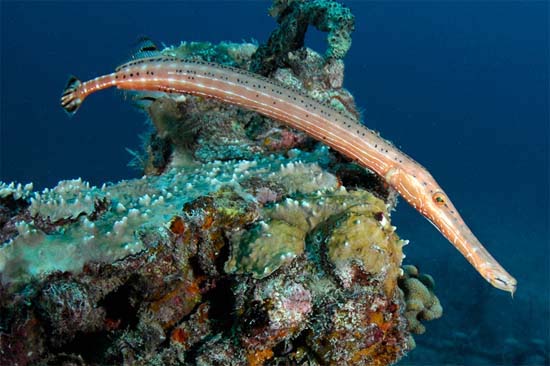
Photo Credit: floridamuseum.ufl.edu
Flute Mouth Fish found singly or in small groups over sandy areas of coastal reefs. They feed on smaller fishes and shrimps. They swim near the bottom above sand or rubble areas and near reefs during the day, can often be seen in small groups at night in shallow protected areas, these fish are often found hovering close to another fish for protection and for hunting.
HALFBEAK FISH
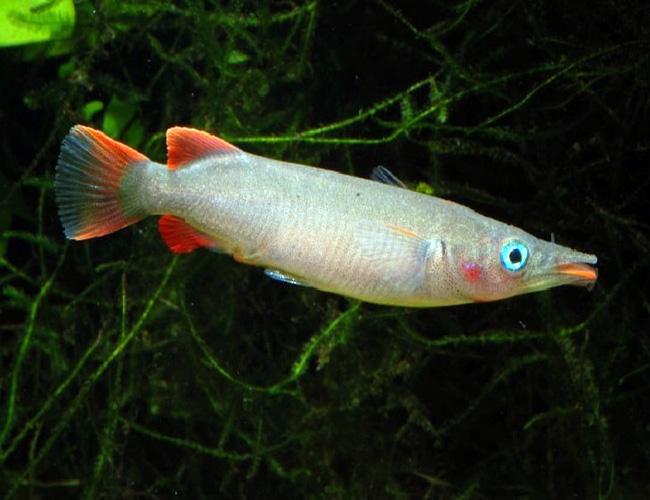
Photo Credit: azgardens.com
Halfbeaks are a type of marine and brackish water fish. These fish are found throughout the world, primarily in warm waters where they tend to inhabit the upper region of the water. The Halfbeak is known for their unique jaw configuration – the lower is significantly longer than the upper. There are numerous species of halfbeak, but most of the brackish species are peaceful community fish. Halfbeaks are generally carnivorous fish by nature, feeding on various insects, crustaceans, and smaller fishes.
HAWKFISH
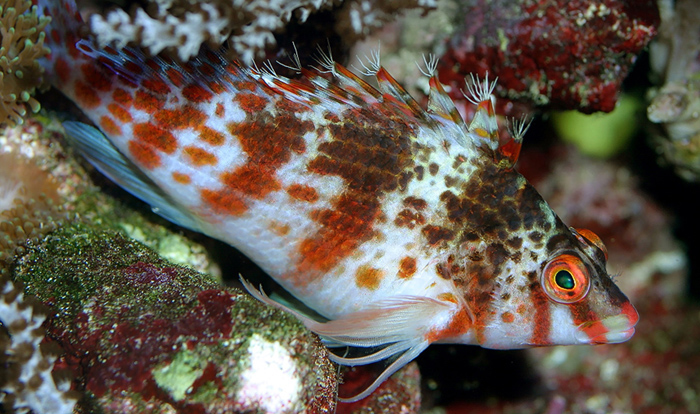
Photo Credit: reefs.com
Most Hawkfish reach a size of three inches and are hardy specimens that adjust well to aquarium life. Keep in mind that while Hawkfish do well in reef aquariums, they will eat smaller shrimp and fish. But, let’s keep them in their natural habitat, the sea. A well-sealed lid and adequate hiding places are required to maintain these fish. Because of this, we can find them in the coastal reefs.
LIZARDFISH
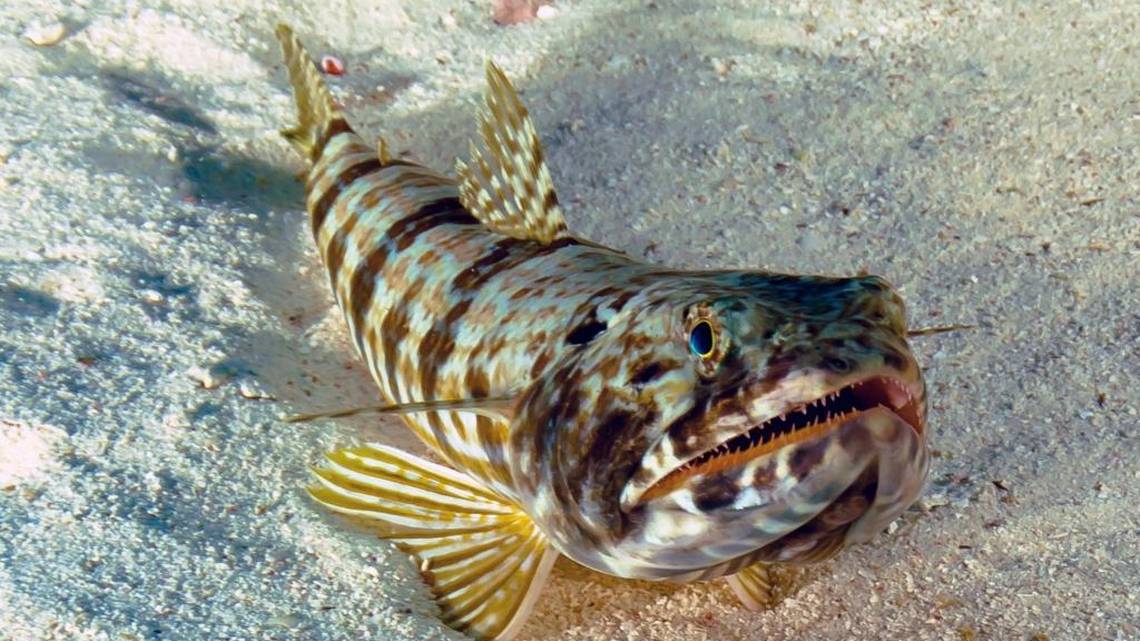
Photo Credit: flkeysnews.com
The Lizardfish is a smaller predator fish that lives in the depths of the water. They are small oval or cylinder shaped fishes. They have mouths that are completely filled with very spiny sharp rather needle-like teeth. Strangely enough, even their tongues have teeth on them.
There are sixty odd species of lizardfish, and each has the tongue teeth as well.
Lizardfish are what is known as an ambush predator, which will sit on the bottom and wait for their prey to come to them before grabbing it in very sharp-toothed jaws. The Lizardfish lives on the bottom and ranges in many different habitats. It can live in coral reefs, and also equally well in silt-filled areas of rubble type habitat.
PARROTFISH
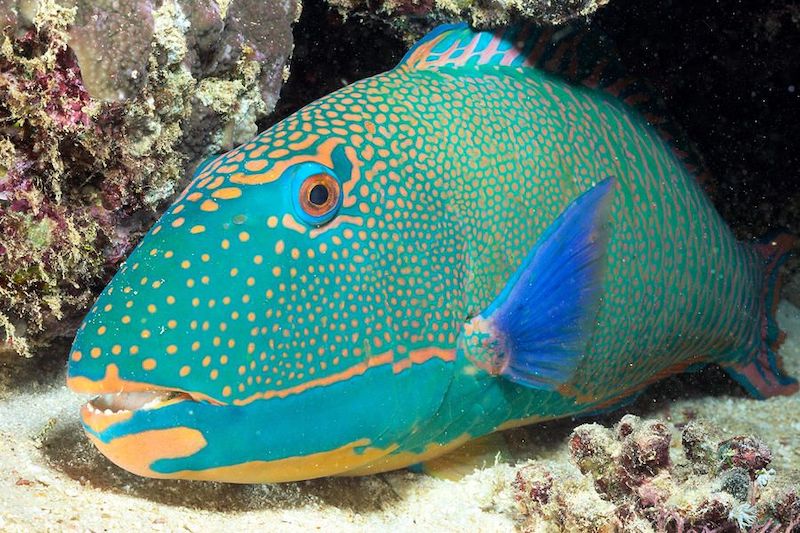
Photo Credit: giftpicz.pw
Parrotfish eat algae and dead coral but sometimes, they do eat living coral too. But the harm done to live coral is far outweighed by the benefits they bring.
They spend up to 90% of their day nibbling. In other words, they clean the reef. This is important because we need them to save reefs.
They have delightfully garish fashion sense. Parrotfish are a big part of what makes scuba diving so colourful and adventurous. Each species has a different colour scheme, and they change their outfits as they go from babies to adolescents, to adults.
PORCUPINEFISH
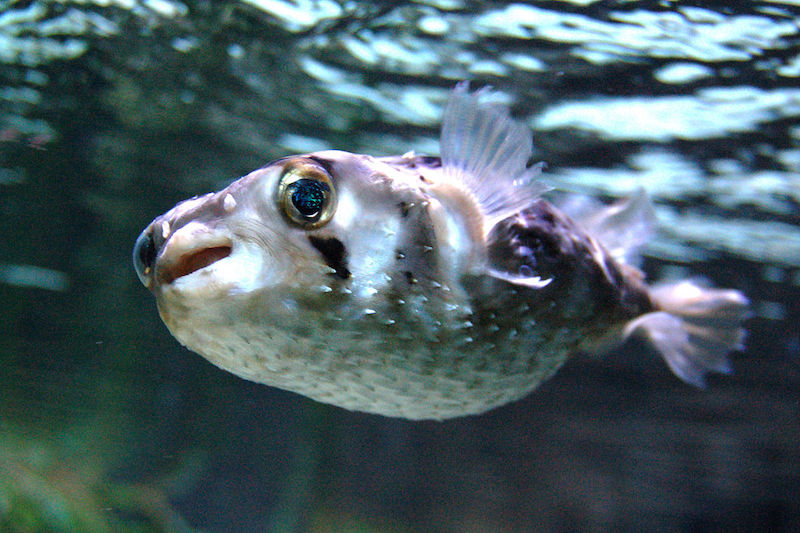
Photo Credit: en.wikipedia.org
They may look cute, but don’t let that fool you. One wrong move and POOF! You’re staring at a big, spiny ball that only the bravest sharks would dare eat. This prickly master of self-defence is the porcupine fish.
These fishes grow up to three feet in length. They have large, rounded heads, and pale bodies that may be covered in brown or black spots. While most fish are covered in flat scales, porcupine fish have sharp spines. Their spines lay flat against their bodies until they sense danger. Then they fill up with water or air, growing to three times their normal size!
Porcupine fish live in mild to warm oceans, like Africa. They tend to hide out in coral or rocky caves, but will sometimes swim around in the open. Young porcupine fish swim in the open ocean and seek shelter in seaweed.
They have a crunchy diet! They eat hard-shelled animals like crabs, snails and sea urchins, but will also eat sea jellies. They have large mouths and strong teeth to help them crunch through shells.
PUFFERFISH
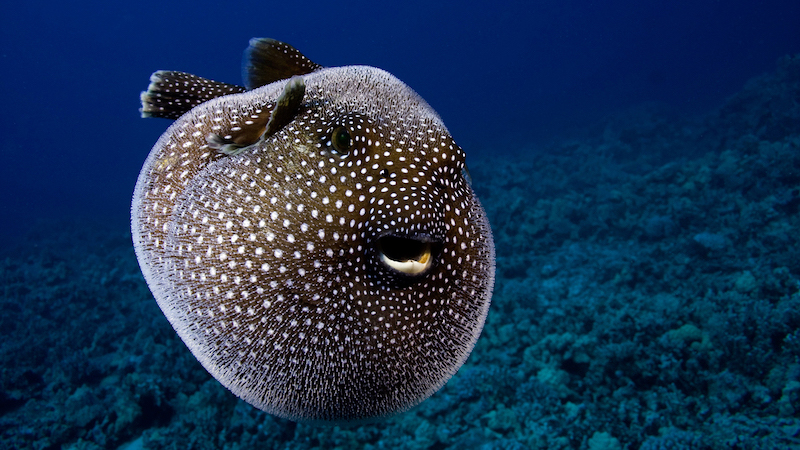
Photo Credit: kids.nationalgeographic.com
Imagine you are swimming in the crystal blue ocean. You see what looks like an ordinary fish with a rounded head and big eyes and decide to take a closer look. As you float closer, that normal looking fish suddenly blows up to twice its size and looks like a balloon covered in spikes! You’ve just met a pufferfish!
A pufferfish is a fish that is usually poisonous and can blow up into a ball several times its regular size. The smallest pufferfish are about an inch long, and the largest is over twenty-four inches long!
The pufferfish’s poison is deadly to humans and some animals if eaten. If an animal succeeds in eating a pufferfish before it puffs up, it will probably be the last meal it ever eats. The poison in their body and organs is so strong, one pufferfish can kill up to thirty people if they eat it, and there is no cure.
TRIGGERFISH
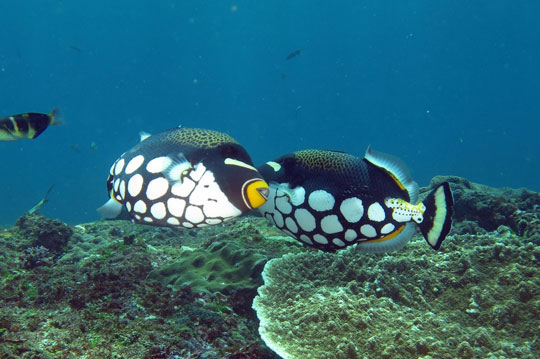
Photo Credit: dive-the-world.com
The triggerfish is commonly known as the grey triggerfish. It is brownish green to grey in colour and reaches a maximum length of 40cm. They can be found in mainly rocky bottoms and floating wreckage at depths between 10-100 m. They mostly feed on seaweed and alges.
And here are some plants;
GRACILARIA
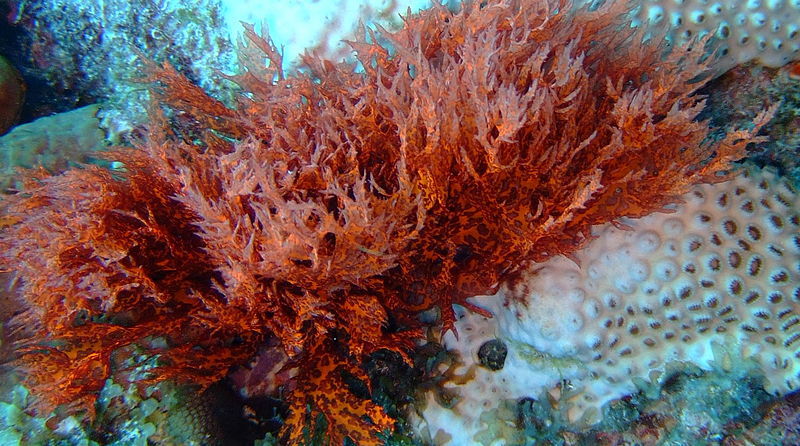
Photo Credit: pediaa.com
Of the more than 6,000 species of red algae, most are, not surprisingly, red, reddish, or purplish in colour. All algae get their energy from photosynthesis, but one thing that distinguishes red algae from other algae is that their cells lack flagella, the long, whiplike outgrowths from cells that are used to generate locomotion and sometimes serve a sensory function. Also surprisingly, they are not technically plants, although like plants they use chlorophyll for photosynthesis and they have plant-like cell walls. Red algae are found around the world, from polar waters to the tropics, and are commonly found in tide pools and in coral reefs.
Red algae are an important part of the world’s ecosystem because they are eaten by fish, crustaceans, worms, and gastropods, but humans also eat these algae.
Nori, for example, is used in sushi and for snacks; it becomes dark, almost black when it is dried and has a green hue when cooked. Irish moss, or carrageenan, is an additive used in foods including pudding and in the production of some beverages, such as nut milk and beer.
EUCHEUMA
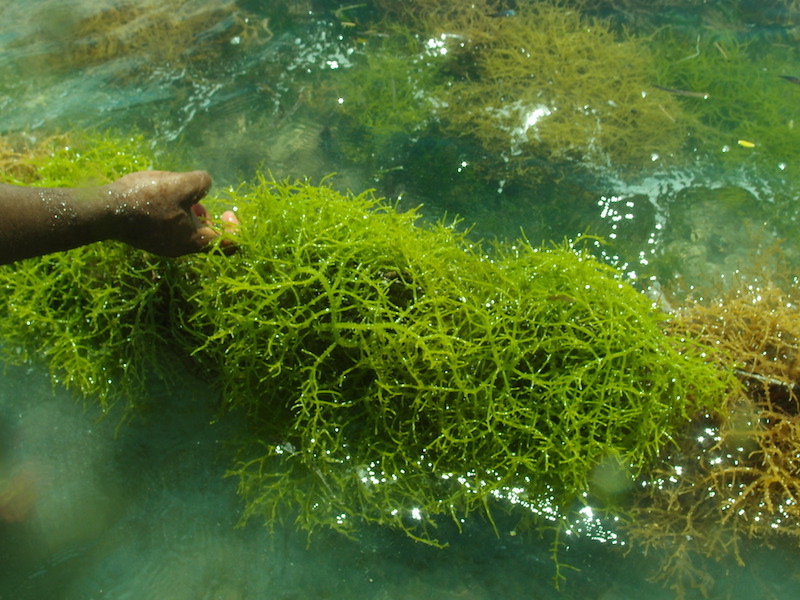
Photo Credit: en.wikipedia.org
Eucheuma is a seaweed alga that may be brown, red, or green in colour. Species are used in the production of carrageenan, an ingredient for cosmetics, food processing, and industrial manufacturing, as well as a food source. Since the mid-1970s, Kappaphycus and Eucheuma have been a major source for the expansion of the carrageenan industry.
They are typically found below the low tide mark to the upper subtidal zone of a reef, growing on the sand to rocky seafloor areas along a coral reef, where water movement is slow to moderate.
CHLOROPHYTA
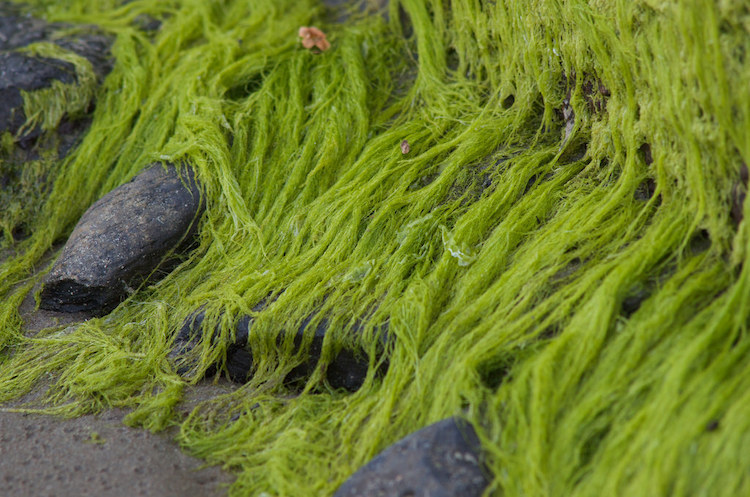
Photo Credit: hiveminer.com
Chlorophyta is commonly known as green algae and sometimes, loosely, as seaweed. Like other algae, green algae serve as an important food source for herbivorous marine life, such as fish, crustaceans, and gastropods, including sea snails. Humans use green algae as food, too. and it has long been part of the cuisine of Japan. There are more than 30 species of edible seaweed, which is naturally rich in minerals such as calcium, copper, iodine, iron, magnesium, manganese, molybdenum, phosphorous, potassium, selenium, vanadium, and zinc. Edible types of green algae include sea lettuce, sea palm, and sea grapes.
The pigment beta carotene, found in green algae, is used as a food colouring. Carotene also has been shown to be very effective in preventing some cancers, including lung cancer.
MANGROVES

Photo Credit: blueocean.net
If you’ve ever spent time by the sea in a tropical place, you’ve probably noticed distinctive trees that rise from a tangle of roots wriggling out of the mud. These are mangroves—shrub and tree species that live along shores, rivers, and estuaries in the tropics and subtropics. Mangroves are remarkably tough. Most live on muddy soil, but some also grow on sand, peat, and coral rock. They live in water up to 100 times saltier than most other plants can tolerate. They thrive despite twice-daily flooding by ocean tides; even if this water were fresh, the flooding alone would drown most trees. Growing where land and water meet, mangroves bear the brunt of ocean-borne storms and hurricanes.
Thinking about visiting coasts for a little marine adventure? You can get your flight tickets here and have some adventure under the water.
That’s the end of our list of marine life in Kenya for now. Why not sign up for our weekly newsletter and be the first to take advantage of fast-selling fares to your favourite destinations? Click here to never miss the best travel deals.